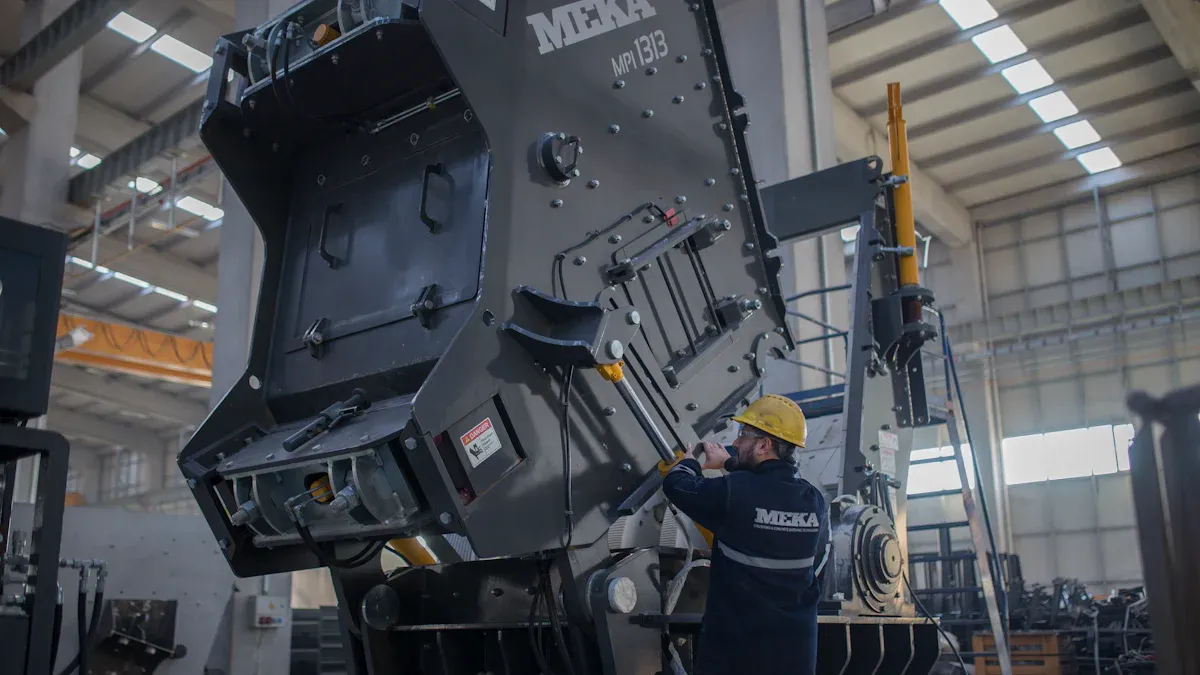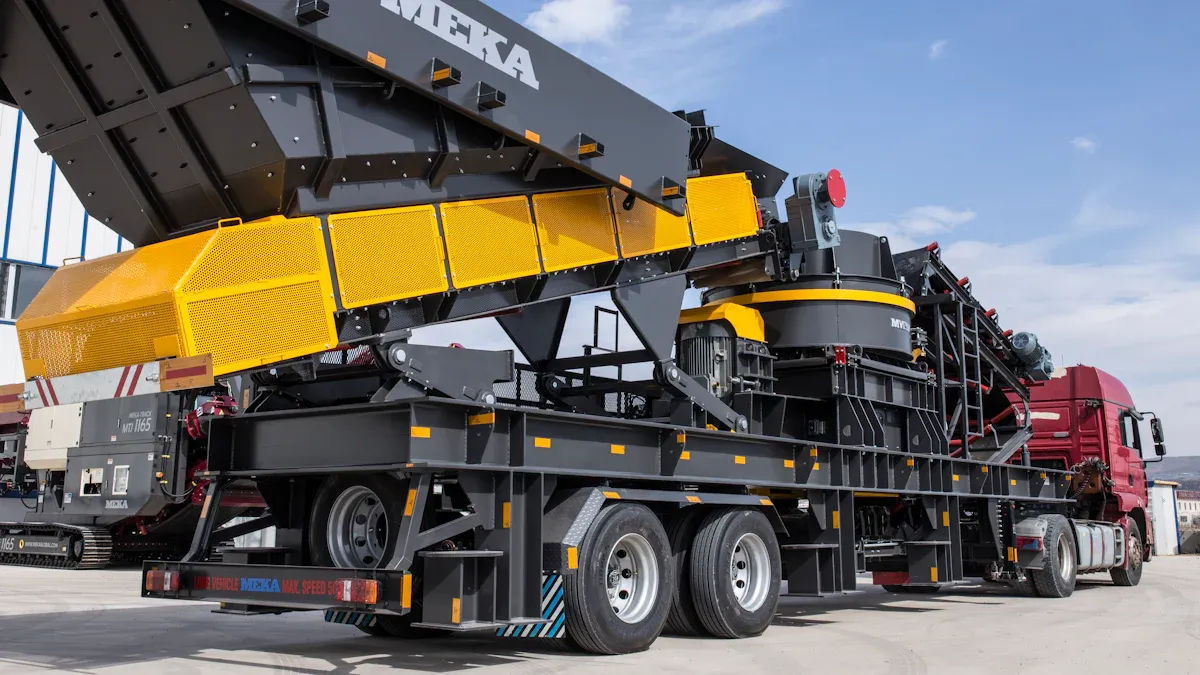
Extending the lifespan of crusher wear parts can significantly improve your operations. By reducing blockages and stoppages, you can achieve smoother workflows and lower costs. For instance:
Real-time detection of oversized rocks has reduced crusher blockages by 82%.
Cement crusher operations have seen a 20% drop in unwanted stoppages.
These improvements not only save time but also minimize energy usage. Energy consumption often accounts for 50% of operating costs, making proper maintenance and optimized settings crucial. Even small adjustments, like using high-efficiency motors or Variable Frequency Drives (VFDs), can cut energy use by 2-30%.

Choosing the right crusher wear part is essential for improving your equipment's performance and longevity. The correct parts can reduce energy consumption, minimize downtime, and enhance productivity. Below are three key considerations to help you make the best choice.
Every crushing application is unique, and the material being processed plays a significant role in wear part selection. For example, abrasive materials like granite require wear parts with high resistance to wear, while softer materials may need parts designed for impact resistance.
Changing the chamber design can improve your operation if the current wear parts fail to meet your needs.
Properly sized and selected wear parts ensure a sustainable and efficient crushing process.
Using the right replacement parts helps maintain productivity and extends the life of your equipment.
By matching the material to the application, you can optimize your crusher's performance and reduce unnecessary wear.
The hardness and toughness of the material being crushed directly affect wear part performance. Harder materials cause more wear, while tougher materials can resist breakage. Selecting wear parts designed to handle these conditions ensures durability and efficiency.
For instance, wear parts that last 2-4 times longer can significantly reduce replacement frequency. This not only saves costs but also minimizes resource use. Additionally, energy consumption can drop by up to 30%, lowering costs per ton and improving overall efficiency.
Working with a trusted supplier ensures you receive high-quality crusher wear parts that meet your operational needs. Reliable suppliers provide parts designed for compatibility and durability, reducing maintenance requirements and improving performance.
Partnering with Metso Outotec increased production efficiency by 98% for one operation.
OEM parts offer a reliable supply chain and optimal compatibility, enhancing equipment availability.
A large construction company reduced repair costs and increased output by switching to durable parts from a reputable supplier.
Collaborating with experienced suppliers also gives you access to on-site expertise, helping you make informed decisions and achieve better results.

Regular maintenance is essential for extending the lifespan of crusher wear parts and ensuring smooth operations. By adopting proactive strategies, you can minimize downtime, reduce costs, and improve equipment performance.
Routine inspections help you identify wear patterns and minor issues before they escalate into major problems. For example, inspecting jaw plates regularly allows you to flip them when half-worn, preventing excessive damage. Similarly, monitoring blow bars weekly ensures timely replacements based on wear levels.
Tip: Early detection of loose bolts or overheating can prevent catastrophic failures and costly repairs. Predictive maintenance systems have achieved up to 90% accuracy in forecasting potential issues, reducing downtime by 20%.
By analyzing wear patterns during inspections, you can optimize crusher settings and improve product quality. Regular monitoring also enhances safety by preventing unexpected failures.
Consistent cleaning and lubrication are vital for maintaining crusher wear parts. Dirt and debris can accelerate wear, while insufficient lubrication increases friction and heat, leading to premature failure. Industry experts emphasize that thorough maintenance significantly extends equipment lifespan.
In 2023, 43.44% of facilities planned to increase maintenance budgets, recognizing its importance for asset longevity.
Regular lubrication reduces energy consumption and operational disruptions, ensuring smoother workflows.
Note: Use high-quality lubricants and follow manufacturer guidelines to maximize the effectiveness of your maintenance efforts.
Proactively replacing worn parts prevents costly failures and unplanned downtime. CMMS software can automate preventive maintenance schedules, track asset history, and forecast equipment failures using predictive analytics.
| Aspect | Preventive Maintenance | Reactive Maintenance |
|---|---|---|
| Initial Investment | Requires specialized tools and training | Minimal initial costs |
| Downtime | Reduces downtime through planned maintenance | Increases downtime due to unexpected failures |
| Equipment Lifespan | Prolongs lifespan by addressing wear early | May lead to premature replacements |
| Overall Costs | Lower long-term costs due to efficiency | Higher costs from unplanned repairs |
Replacing parts before they fail ensures operational continuity and reduces repair costs. For example, a mining company reduced wear by 30% by adjusting feed rates after analyzing wear data. Early intervention leads to longer equipment lifespan and lower maintenance expenses.
You can reduce wear by adjusting crusher settings to match the material characteristics. Different crushers operate differently, and their settings impact wear rates. For example:
- Hard materials require tighter settings to achieve efficient crushing.
- Proper feed gradation ensures uniform wear and energy distribution.
- Controlled feed rates prevent uneven wear and improve efficiency.
Material hardness also plays a key role. Softer materials may need wider settings, whil e harder materials demand precise adjustments. By tailoring settings to the material, you can extend the lifespan of your crusher wear parts and maintain consistent performance.
Overloading accelerates wear and reduces equipment lifespan. You can prevent this by monitoring feed rates and ensuring uniform distribution. Excessive loads cause uneven wear patterns and increase the risk of breakdowns.
| Findings | Description |
|---|---|
| Excessive vehicle axle loads | Accelerate wear and reduce structural lifespan. |
| Impact on urban areas | High traffic leads to premature deterioration of road pavements. |
| Evidence from studies | 48% of journals highlight the effects of overloading on infrastructure. |
Choke feeding is an effective strategy to avoid overloading. It maximizes crushing action and ensures even energy distribution. By maintaining optimal feed rates, you can minimize wear and improve operational efficiency.
Tracking performance metrics helps you identify issues before they escalate. Real-time monitoring systems, like XMPro's predictive analytics, detect early warning signs of equipment problems. These systems analyze operational data and provide actionable insights to prevent costly breakdowns.
| Performance Metric | Definition | Optimization Strategies |
|---|---|---|
| Feed Size | The size of the rocks entering the crusher. | Ensure the feed size is within the recommended range; use pre-screening to remove fines. |
| Discharge Size | The size of the crushed material exiting the crusher. | Adjust the discharge opening to achieve the desired final product size; regularly check settings. |
| Crushing Ratio | The ratio of the feed size to the discharge size. | Balance the crushing ratio to achieve optimal efficiency and product quality. |
| Throughput | The amount of material processed per unit of time. | Ensure uniform feed rate; use vibrating feeders to maintain a steady feed. |
By monitoring these metrics, you can optimize crusher settings, reduce wear, and maintain consistent performance. Early detection ensures timely interventions, saving costs and extending equipment lifespan.
Extending the lifespan of crusher wear parts starts with selecting the right parts, maintaining them regularly, and optimizing crusher settings. These strategies reduce downtime, lower costs, and improve equipment performance.
Modifications to crusher settings have reduced vibration levels from 1.60 mm/sec to 1.09 mm/sec, cutting maintenance frequency from every 10 days to once a month.
Preventive maintenance strategies enhance equipment longevity and minimize unplanned downtime, which is critical for profitability.
| Cost Type | Estimated Cost Range |
|---|---|
| Repairs or replacement | $50,000 - $100,000 |
| Lost production | $10,000 - $20,000 per day |
| Overtime for employees | $5,000 - $10,000 per day |
| Shipping and handling | $1,000 - $2,000 |
By applying these tips, you can achieve better equipment health and operational efficiency. Consult industry experts to tailor these strategies to your specific needs and maximize your crusher’s potential.
Crusher wear parts are components designed to protect crushers from damage during operation. They include items like jaw plates, blow bars, and mantles. These parts endure heavy wear and tear, ensuring your crusher performs efficiently.
Replace crusher wear parts when they show significant wear or reduced performance. Regular inspections help you identify the right time for replacement, preventing equipment failures and downtime.
Yes, adjusting crusher settings to match material characteristics reduces wear. Proper feed rates and uniform distribution minimize stress on wear parts, extending their lifespan and improving efficiency.
Material selection ensures wear parts can handle the specific conditions of your crushing application. Harder materials require tougher parts, while softer materials need impact-resistant components for optimal performance.
Routine maintenance, including cleaning and lubrication, prevents premature wear. Early detection of issues during inspections ensures timely replacements, reducing costs and extending the lifespan of wear parts.